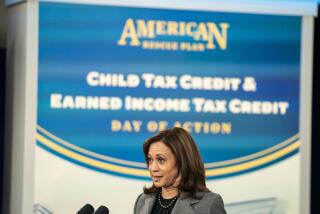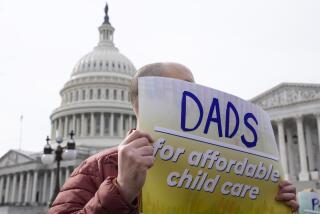Welfare Debate Puts Blame for Poverty Mainly on Poor : Analysis: Self-destructive behavior is seen as a key cause. For decades, policy was shaped by faulting society.
WASHINGTON — The debate over welfare reform marks a genuine milestone in an argument that has shaped social policy for generations.
Literally since Colonial days, the debate over poverty in America has revolved around the same question: Is the persistence of poverty primarily the fault of society, or of the poor themselves?
One side in this argument is never entirely triumphant. Both explanations always find at least some favor and the tension between them defines the evolution of policy, first in one direction, then in the other. The vast patchwork of government programs that deal with poverty often involve a compromise, or a standoff, between the two views.
But at any given point, one side or the other in this argument typically holds the upper hand and this week’s welfare debate symbolizes the ascendancy of the perspective that affixes blame for poverty primarily to self-defeating and self-destructive behavior by the poor.
Sensitive to charges that they are lacking in compassion, Republican lawmakers are insisting that the real villains in this drama are government programs that encourage bad behavior. “What is really cruel is the current incentive that pulls young women into the system and holds them forever in this cruel trap,” declared Rep. Jan Meyers (R-Kan.).
But the bottom line, according to the prevailing conservative analysis, is that only moral renewal can uplift the poor and only a retrenchment of government aid to the poor can furrow the ground for moral renewal. As the debate commenced this week, House Ways and Means Committee Chairman Bill Archer (R-Tex.) summarized that belief in the bluntest possible terms: “This bill will reverse the decades-long federal policy of rewarding unacceptable and self-destructive behavior. We will no longer reward for doing the wrong thing.”
President Clinton, to a far greater extent than the new Republican majority in Congress, has argued for a continuation of material assistance to help bring the poor into the economic mainstream. He has advocated such ideas as a more generous earned income tax credit, guaranteed universal health care and expanded training and education for welfare recipients.
*
But Clinton probably did as much as anyone else to shift the debate toward individual behavior by linking his calls for aid with demands for “personal responsibility” and by decrying moral breakdown from a pulpit in Memphis, Tenn., where Dr. Martin Luther King Jr. once preached. When Clinton failed to push his own welfare reform proposal during the first two years of his presidency, Republicans appropriated the personal responsibility theme but virtually discarded the call for more government aid.
The focus on individual behavior across the political spectrum reverses the prevailing attitude of the 1960s, the last great wave of social policy reform.
Even then, liberal reform advocates often spoke about the need to “rehabilitate” the poor from a pervasive “culture of poverty,” as noted by historian James T. Patterson in his book, “America’s Struggle Against Poverty.” But, as the civil-rights and welfare-rights movements gained strength through the decade, the focus on behavior operated within steadily constricting boundaries of acceptability.
The historic turning point came in 1965, when Daniel Patrick Moynihan, then an assistant secretary of labor and now a Democratic senator from New York, wrote that a rising illegitimacy rate threatened to submerge the African American community in a “tangle of pathology.”
On the left, Moynihan was roundly denounced as racist. Even his assumption that two-parent families were preferable came under assault. “What may seem to be a disease to the white middle class may be a healthy adaptation to the Negro lower class,” declared civil rights leader Bayard Rustin.
Especially in the wake of Moynihan’s repudiation, discussions about alleviating poverty shifted from changing the behavior of the poor to directly improving their economic circumstances.
“The assumption was what made poor people poor was a lack of money to spend, not a cultural deprivation,” said historian David J. Garrow.
Once the assumption took root that external, not internal, conditions created the problems of the poor, reformers logically looked to government to eliminate those barriers. President Lyndon B. Johnson responded with his War on Poverty.
Never as sweeping in impact as either its critics or supporters contended, the War on Poverty offered an array of educational, training and other programs intended to expand opportunity among the poor. In what inadvertently became its most celebrated idea, the Johnson Administration created local administrative structures intended to give poor people greater control over federal funds flowing into their neighborhoods.
All of this reflected a conviction that poverty was rooted in an absence of resources--not only material but political. Given the tools to exert greater control over their lives, Great Society planners argued, the poor would be able to break the shackles of poverty. “The whole community participation idea . . . comes very directly out of the Southern (civil rights) movement ethos that poor people could organize themselves and move forward if they got together,” said Garrow, a professor of history at the College of William and Mary.
The concept of empowering the poor through control of federal funds collapsed under enormous resistance from big-city mayors. But the underlying idea that improving the situation of the poor depended more on material than cultural factors survived the end of the Johnson Administration.
In 1969, a presidential commission headed by prominent industrialist Ben W. Heineman came down firmly on that side of the argument. “The poor inhabit a different world than the non-poor, primarily because they lack money,” the commission concluded. It recommended that government provide a minimum income to all families, according to Patterson.
To a considerable extent, that perspective shaped the welfare reform debates of the 1970s. Presidents Richard Nixon and Jimmy Carter both proposed variations of plans that would guarantee minimum incomes to all poor families, greatly expanding welfare rolls but requiring work from most able-bodied recipients without young children.
Both plans were significantly more generous than anything on the table today. But both were killed in Congress by a coalition of conservatives, who considered them too generous, and liberals, who loathed the work requirements and demanded guaranteed incomes higher than either President had proposed.
When Congress passed the Family Support Act in 1988, the focus was primarily on moving people already on welfare into the work force through training, education and work requirements. Its impact has been limited, partly because states have failed to provide the matching funds required to trigger federal aid.
Throughout this long debate, the cultural explanation for poverty was almost totally eclipsed. Neither Nixon nor Carter addressed illegitimacy at all in his welfare plans. Nor did the Family Support Act signed into law by then President Ronald Reagan directly deal with discouraging out-of-wedlock births.
Through the early 1990s, the inexorable rise in illegitimacy--and the growing concern that fatherlessness contributed to the upsurge of violent juvenile crime--raised alarms across a widening segment of the political spectrum. A turning point came in 1992 when a black Democratic state legislator in New Jersey shepherded into law a “family cap” bill denying additional aid to women who had children while already on welfare.
The drumbeat grew even louder in 1993, when conservative social scientist Charles Murray, a longtime critic of the welfare system, published an analysis declaring illegitimacy the fundamental problem in American society--and arguing that the availability of welfare itself increases out-of-wedlock births by cushioning its economic consequences.
Though many liberal academics continue to dispute the argument that welfare encourages out-of-wedlock births, Murray’s premise that it enables such behavior is more difficult to refute. The article accelerated the shift toward personal behavior as the center of the welfare debate. It strengthened the growing willingness of some Democrats to declare rising illegitimacy rates a danger.
Reinforced by arguments from conservative analysts like Robert Rector of the Heritage Foundation and former Education Secretary William J. Bennett, it convinced House Republicans to shift the focus of their bill toward discouraging illegitimacy by denying cash benefits to women younger than 18 who bear children out of wedlock and by requiring all states to adopt a family cap like New Jersey’s.
This focus on influencing behavior echoed concerns voiced during the first half of the century. Out-of-wedlock births were very much on the minds of the original advocates of the mothers’ pension system that proliferated in the states after 1911 and formed the basis for the federal welfare program created during the New Deal.
The mothers’ pensions were framed as programs for widows, whose poverty could not be portrayed as their own fault. Even divorced or deserted women, to say nothing of those who gave birth outside of marriage, were excluded from some of the state programs.
*
Indeed, the requirement that recipients of aid retain a “suitable home,” a restriction used to deny assistance to women who bore children outside of marriage, was a cornerstone of the program even after the federal government took it over in 1935. But that stricture gradually lost force in the decades after World War II. By the 1960s, it had disappeared as part of the general loosening of social attitudes toward sex.
There is no question that the rising rate of illegitimacy--now running at three of every 10 births--has inspired a counterrevolution across the political spectrum. But this week’s impassioned House debate suggests that it remains unclear how far the country is willing to go to coerce women not to bear children out of wedlock.
* WELFARE COUNTDOWN: House took last steps before final vote on welfare plan. A18
More to Read
Get the L.A. Times Politics newsletter
Deeply reported insights into legislation, politics and policy from Sacramento, Washington and beyond. In your inbox three times per week.
You may occasionally receive promotional content from the Los Angeles Times.










